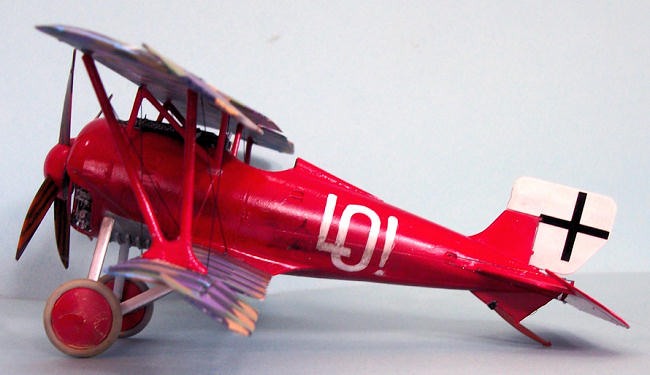
Roden 1/32 Siemens-Schuckert D. III (late)
| KIT #: | 610 |
| PRICE: | $69.99 SRP |
| DECALS: | Three options |
| REVIEWER: | Tom Cleaver |
| NOTES: | Loon Models corrected resin horizontal stabilizer used; Techmod lozenge decals used; Airscale instrument decals used |

| HISTORY |
Considered by many of the pilots who flew it to be the best
fighter to see action during the war, the Siemens-Schuckert D.
Siemens-Schuckert, which had originally produced the R.I heavy
bomber, entered fighter production with an almost-exact copy of the
French Nieuport 17, known as the Siemens-Schuckert D.I, 95 of which were
produced in 1916 and relegated to use as trainers, due to the
unavailability of the Oberursel Ur.II rotary in a useful timeframe.
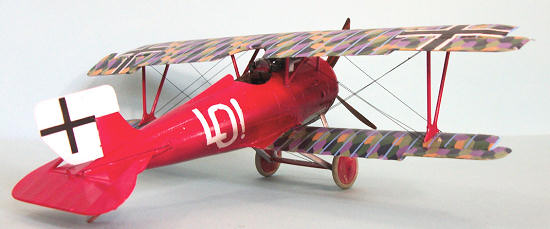 To solve the engine problem, Siemens‑Halske began work on newer
rotary engine designs that would not be outdated before entering
service. The 1560
horsepower Siemens‑Halske Sh.
To solve the engine problem, Siemens‑Halske began work on newer
rotary engine designs that would not be outdated before entering
service. The 1560
horsepower Siemens‑Halske Sh.
With the Sh.
On the basis of these tests, three more prototypes were ordered -
two D.IIc's with shorter and longer span wings, and the D.IIe with the
original-span wings. By
October 1917 the design proved to be worth producing, and an order for
twenty long‑span D.IIc's with a smaller 4‑bladed propeller that allowed
for shorter landing gear legs was made in December. Renamed the D.
All 50 were sent to Jagdgruppe II in May, 1918, where they
proved popular, with Jasta 15 taking on several, one of which was
flown by newly-arrived Leutnant Oliver von Beaulieu-Marconnay to
score his first two victories.
Unfortunately, after only about 10 hours' service,
the engines began overheating and eventually seizing. Siemens
blamed the problem on the
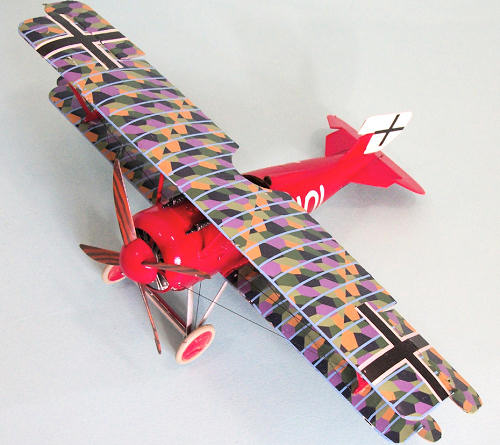 Voltol‑based
oil used to replace scarce castor oil, but the airplanes were withdrawn
from service and replaced by Fokker D.
Voltol‑based
oil used to replace scarce castor oil, but the airplanes were withdrawn
from service and replaced by Fokker D.
A modified version of the Sh.
Although the short landing gear and limited propeller clearance
made for tricky landing, the D.
Ernst Udet, commander of Jasta 4, was issued a D.
Because the victorious Allies considered the aeronautically
advanced SSW D.
| THE KIT |
Roden has released a 1/72 scale kit of this airplane several years
ago, and Eduard released a 1/48 kit in the early 1990s as one of their first
very limited-run kits. This kit
by Roden was released two years ago and is the only kit of this airplane in
this s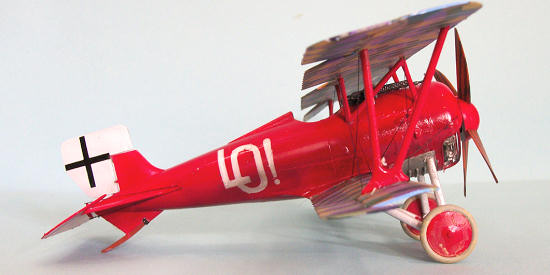 cale.
Markings are provided for three airplanes, including that allegedly
flown by Udet, along with one-piece lozenge sheets for upper and lower
surfaces of the wings.
cale.
Markings are provided for three airplanes, including that allegedly
flown by Udet, along with one-piece lozenge sheets for upper and lower
surfaces of the wings.
It is alleged that the larger elevator supplied in the kit is
incorrect, and a smaller version in resin was released by Loon Models.
There are not that many photos of the airplane that show the tail,
though there are drawings that show both.
The larger elevator may be associated with the very-similar SSW D.IV.
I opted to use the replacement stabilizer to see how it works.
As is always the case with Roden, the fabric surface detail of the
wings and control surfaces is highly accurate without a lot of “hills and
valleys.”
| CONSTRUCTION |
Construction of the kit is straightforward.
The best guess is that the interior was varnished natural wood, so I
painted the interior that way.
I used Airscale World War I instrument decals and Eduard photoetch seatbelts
to dress up the cockpit.
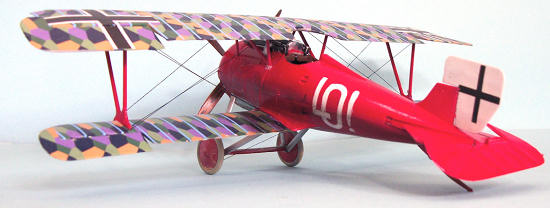
| COLORS & MARKINGS |
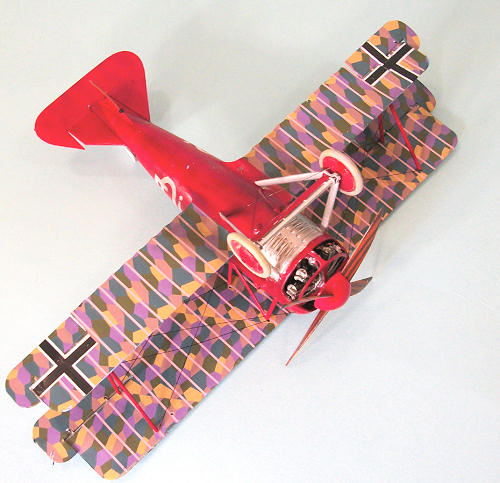 hat
Udet used his influence to get red paint from the civilian market for his
Fokker D.
hat
Udet used his influence to get red paint from the civilian market for his
Fokker D.
I opted to use the Techmod decals because they looked to be more
accurate in terms of color than the kit decals and likely better in
production quality. The Techmod
sheet does not have separate strips, which made doing the upper wing with
its fabric strips applied at an angle a much easier affair than would be the
case with individual strips applied side by side.
The lozenge on the lower wing was applied in one continuous strip
span-wise, which was also easy.
When the upper and lower decals had set, I used the colored rib tapes to do
light blue on the upper surfaces and pink on the lower surfaces.
Photos show these airplanes with both colored tapes and lozenge
tapes.
The Roden kit decals used for Udet's personal marking and the
national insignia did indeed cause trouble.
They separated into pieces after being soaked, and had to be
carefully applied and pieced together.
They also resisted Micro-Sol and eventually only went down under
several applications of Solvaset.
Once they were set, I had to over-paint them to cover the broken
areas. I washed the model then
and gave it a coat of Xtracrylix Satin varnish.
| FINAL CONSTRUCTION |
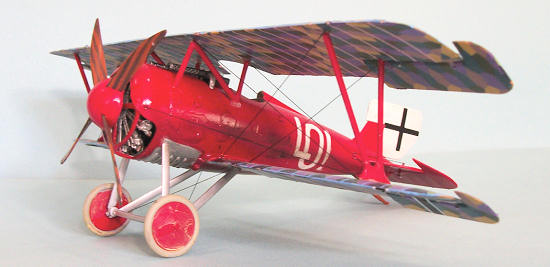 I attached the interplane and cabane struts, attached the wings, and
then attached the separate ailerons in a “dynamic” pose.
I attached the interplane and cabane struts, attached the wings, and
then attached the separate ailerons in a “dynamic” pose.
Though it is unknown if Udet ever flew this airplane in combat, I
decided to finish it as it might have looked if he had.
The oil used on rotary engines got sprayed everywhere over the
airframe, so I made a very liberal application of Tamiya “smoke” over the
wings and fuselage. I also
“muddied” the wheels and gear legs, as the original airplane would have
looked operating from a frontline airfield during the rainy Autumn of 1918
(three of the last eight weeks of the war saw no flying on the Western Front
due to heavy rains). The simple
rigging was done with .008 wire, painted black.
| CONCLUSIONS |
The Siemens-Schuckert D.
Copyright ModelingMadness.com. All rights reserved. No reproduction in any form without express permission from the editor.
If you would like your product reviewed fairly and fairly quickly, please contact the editor or see other details in the Note to Contributors.